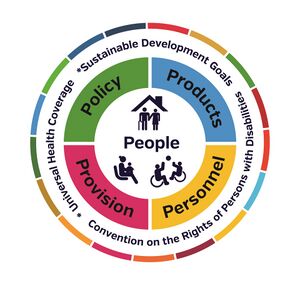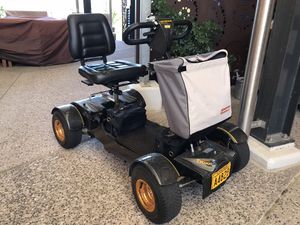Assistive Devices
Top Contributors - Ines Musabyemariya, Lauren Lopez, Redisha Jakibanjar, Lucinda hampton, Kim Jackson, Rachael Lowe, Rucha Gadgil, Naomi O'Reilly, Aminat Abolade, Robin Tacchetti and Angeliki Chorti
Introduction
Assistive devices and technologies are those whose primary purpose is to maintain or improve an individual’s functioning and independence to facilitate participation and enhance overall well-being. Examples of assistive devices and technologies include wheelchairs, prostheses, hearing aids, visual aids, and specialized computer software and hardware that increase mobility, hearing, vision, or communication capacities.[1]
The International Classification of Functioning, Disability, and Health (ICF) defines assistive products and technology as any product, instrument, equipment or technology adapted or specially designed for improving the functioning of a person with a disability. [2]
The International Organization for Standardization (ISO) defines assistive products more broadly as any product, especially produced or generally available, that is used by or for persons with disability: for participation; to protect, support, train, measure or substitute for body functions/structures and activities; or to prevent impairments, activity limitations or participation restrictions.[2]
Assistive devices can incur significant purchase and maintenance costs, especially for children and those undergoing rehabilitation with expected improvement whose growth or changing abilities mean they will outgrow their assistive devices. Depending on your country's health system, there may be some assistive devices that are funded by your government's healthcare or by private insurers. The Standard Rules on the Equalization of Opportunities for Persons with Disabilities also call upon States to support the development, production, distribution, and servicing of assistive devices and equipment and the dissemination of knowledge about them.[3]
The video below shows some of the more readily available great devices out there.
Despite the high cost of assistive devices, having access to it can change the lives of many people in need[5].
The video below shows how assistive devices can change lives.
Barriers to Assistive Devices
UNICEF describes barriers to individuals using assistive devices as follows[2]:
- Lack of awareness
- Lack of governance including legislation, policies and national programmes
- Lack of services
- Lack of products
- Inaccessible environments
- Lack of human resources
- Financial barriers
The recent global report on Assistive Technology added the following barriers to accessing assistive devices[5]:
- Procurement and delivery challenges
- Fragmentation of the Assistive Technology Sector
Strategies for Providing Assistive Devices
As per UNICEF, strategies for providing assistive technology/ devices need to consider the principles of 5 As &Q [2]:
- Availability
- Accessibility
- Affordability
- Adaptability
- Acceptability
- Quality
Availability
Services and products are available in sufficient quantity as close as possible to children’s communities.
Accessibility
Services and products are accessible to everyone who needs them. Their delivery should be equitable to avoid discrepancies between genders, impairment groups, socioeconomic groups and geographic regions.
Affordability
Services and products are affordable to everyone who needs them.
Adaptability
Services and products are adapted and modified to ensure they are appropriate to the needs and requirements of individuals. They need to accommodate differences in terms of individual factors (for example, health condition, body structure, body function, capacity, gender, age, ethnicity and preference) as well as environmental factors (for example, physical environment, psychosocial environment, climate and culture).
Acceptability
Services and products are acceptable to everyone. Factors such as efficiency, reliability, simplicity, safety, comfort and aesthetics should be taken into account to ensure that devices and related services are acceptable.
Quality
Services and products are of appropriate quality. Product quality can be measured through applicable technical standards or guidelines in terms of strength, durability, capacity, safety and comfort.
Strategy to Improve Accessibility of Assistive Devices in Low Resource Settings [6]

WHO through Global Cooperation on Assistive Technology (GATE Initiative), supports member countries to Improve access to Assistive Technology. To achieve this, GATE Initiative focus on 5 Ps.
People
All interventions should consider people`s needs. People centered interventions should be culturally appropriate.
Policy
Policies should ensure everyone has access to the quality assistive devices they need.
Products
Each country should develop a Priority Assistive Product list (APL)that describes the manufacturing minimum quality requirements and ensure adequate supply and affordability of Assistive devices to everyone in need.
Provision
Assistive devices should be integrated at all levels of the healthcare system, to ensure early identification, referral, and assistive technology service provision to all people who need it, thus leading to universal access.
Personnel
Building the capacity of local staff in service provision: assessment, prescription, fitting, follow-up, repairing, and user training.
Types of Assistive Devices
- Mobility
- Wheelchairs
- Canes
- Crutches
- Walkers or walking frames
- Walking stick
- Tricycles
- White cane
- Prosthetics
- Clubfoot brace
- Vision
- Eyeglasses, magnifier, magnifying software for computer
- Communication cards
- GPs app for walking poles
- Hearing
- Hearing aids
- Hearing loops
- Positioning
- Communication
- Communication Cards
- Communication Boards that use eye movements
- Picture Based Instructions / Picture Exchange Communication System
- Communication Electronic Devices ( see video below)
- Everyday Life
- GPS-based Navigation Device
- Timers: Manual or Automatic reminder
- Smartphones with adapted task lists
- Learning
- Adapted Toys and Games
- Braille Systems for reading and writing
- Talking Book Players
Inventive Products
The video below shows some unique assistive devices.
Additional Information
There are outcome measures that gauge the efficiency of an Assistive Device on an individual's life. Some of them are enumerated below:
- Psychosocial Impact of Assistive Devices Scales (PIADS): a 26-item, self-report questionnaire assesses the effects of an assistive device on functional independence, well-being, and quality of life[9]
- Questionnaire for the evaluation of physical assistive devices (QUEAD): evaluates novel physically assisting devices to support developers in their design decisions as well as users during individualizing of their assistive devices[10]
- PYTHEIA: is a self-reported measure subjectively assessing the assistive robotics and other assistive technology devices[11]
Resources
- Global Report on Assistive Technology,2022
- AT Scale: Strategy Overview, Feb 2019.
- Scoping research report on assistive technology, GDI Hub & partners for the UK Department for International Development, 2018.
- Assistive technology in Tajikistan: situational analysis, WHO Europe, 2019.
References
- ↑ WHO. Definition of Assistive Technology. Available from: http://www.who.int/disabilities/technology/en/. (accessed19 April 2023)
- ↑ 2.0 2.1 2.2 2.3 UNICEF, WHO. Assistive Technology for Children with Disabilities: Creating Opportunities for Education, Inclusion and Participation 2015. Available from: https://www.unicef.org/disabilities/files/Assistive-Tech-Web.pdf.(accessed 19 April 2023)
- ↑ The Standard Rules for the Equalization of Opportunities of Persons with Disabilities. New York: United Nations; 1993. www.un.org/esa/socdev/enable/dissre00.htm. (accessed 19 April 2023)
- ↑ Care is there, geriatric management. Assistive devices for the elderly. Available from: https://www.youtube.com/watch?v=IBA1h43J2N8&app=desktop ( accessed 26.4.2019)
- ↑ 5.0 5.1 WHO & UNICEF, Global report on assistive technology, 2022 Available from: https://apps.who.int/iris/bitstream/handle/10665/354357/9789240049451-eng.pdf?sequence=1&isAllowed=y (accessed 19 April 2023)
- ↑ WHO, WHA 71.8- Improving access to Assistive Technology. Available from;https://apps.who.int/gb/ebwha/pdf_files/WHA71/A71_R8-en.pdf?ua=1 (accessed 19 April 2023)
- ↑ Citynews Toronto. Non verbal children with autism learning to communicate through electronic devices. Available from: https://www.youtube.com/watch?v=BPo1H1eMU9k (last accessed 26.4.2019)
- ↑ The superBOO. 7 unique gadgets for elderly living alone. Available from: https://www.youtube.com/watch?v=iPRW4WiuMsg&feature=youtu.be (last accessed 26.4.2019)
- ↑ Jutai J., and Day Hy, Psychosocial Impact of Assistive Devices Scale (PIADS) vol. 14, no. 3, pp. 107-111.DOI: 10.3233/TAD-2002-14305
- ↑ Schmidtler J, Bengler K, Dimeas F, Campeau-Lecours A. A questionnaire for the evaluation of physical assistive devices (QUEAD): Testing usability and acceptance in physical human-robot interaction. IEEE International Conference on Systems, Man, and Cybernetics (SMC), 2017, pp. 876-881, DOI: 10.1109/SMC.2017.8122720.
- ↑ Koumpouros, Y., Papageorgiou, E., Karavasili, A., & Koureta, F. PYTHEIA: A Scale for Assessing Rehabilitation and Assistive Robotics. World Academy of Science, Engineering and Technology, International Journal of Medical, Health, Biomedical, Bioengineering and Pharmaceutical Engineering, 2016; 10, 522-526.







